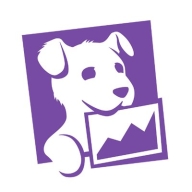

Splunk AppDynamics, Datadog, and Splunk compete in comprehensive monitoring and APM capabilities. Splunk AppDynamics seems to have an advantage in code-level deep dive analysis, while Datadog stands out for its user-friendly dashboarding and integration features.
Features: Splunk AppDynamics offers benefits like code-level deep dive analysis, JVM memory monitoring, and transaction snapshots that provide actionable insights. It also includes a thorough application flow map for visualization. Datadog is praised for strong dashboarding, an integrated tagging system, and slack integration, allowing for seamless monitoring and powerful API integrations, including APM support across multiple environments.
Room for Improvement: Splunk AppDynamics users report issues such as the complexity of licensing, high resource consumption, and difficult integration with older technologies. For Datadog, users emphasize a need for better pricing transparency, improvements in query performance, and the resolution of real-time data display delays and integration issues related to logs and metrics.
Ease of Deployment and Customer Service: Splunk AppDynamics is mostly deployed on-premises, offering strong support across public cloud and hybrid environments, with praised customer service. Datadog primarily serves public cloud environments, noted for easy deployment and prompt customer service. Both solutions offer different user experiences based on technical demands and setup complexities.
Pricing and ROI: Splunk AppDynamics has a premium pricing model, causing concerns over complex licensing and high costs with additional features, though ROI is considered favorable due to performance enhancements. Datadog is seen as reasonably priced but can become expensive with additional features; its usage-based pricing may result in unexpected expenses. However, its detailed monitoring offers value by reducing downtime and optimizing performance, leading to a good ROI.
According to errors, exceptions, and code-level details related to their application performance on a daily basis, the application development team tries to help with Splunk AppDynamics to reduce errors and exceptions, which helps the end users get application availability and feel more confident.
To understand the magnitude of it, when the company asked to replace Splunk AppDynamics with another tool, I indicated that for the proposed tool, we would need five people to do the analysis that Splunk AppDynamics enables me to do.
It's very hard to find ROI because we are currently focused only on the on-premises applications.
AppDynamics is much more helpful.
We got a contact, an account manager, to work directly with for technical support.
They help us resolve any issues raised by our team relating to operations, application instrumentation, or any other issues.
We have reached maximum capacity in our tier, and extending capacity has not been cost-effective from Splunk's perspective.
I would rate the scalability of Splunk AppDynamics as a nine out of ten.
I did not find any Docker solution available with it, and a separate instance has to be installed.
It is necessary to conduct appropriate testing before deploying them in production to prevent potential outages.
There are no issues or bugs with the 20.4 version; it is very stable with no functionality or operational issues.
I can rate it nine out of ten.
The documentation is adequate, but team members coming into a project could benefit from more guided, interactive tutorials, ideally leveraging real-world data.
In future updates, I would like to see AI features included in Datadog for monitoring AI spend and usage to make the product more versatile and appealing for the customer.
There should be a clearer view of the expenses.
Splunk AppDynamics does not support the complete MELT framework, which includes metrics, events, logging, and tracing for the entire stack.
If AppDynamics could develop a means to monitor without an agent, it could significantly improve application performance and reduce potential problems.
A good integration with Splunk would be very interesting, as Splunk is a good product for logs, and that part is currently missing in Splunk AppDynamics.
The setup cost for Datadog is more than $100.
Customers have to pay a premium price, however, they receive considerable value from the product.
All these solutions at the moment are cheap, but it is like paying for insurance; you pay insurance to avoid major damage.
We find its pricing reasonable and competitive.
Our architecture is written in several languages, and one area where Datadog particularly shines is in providing first-class support for a multitude of programming languages.
The technology itself is generally very useful.
We have multiple tools, but end users prefer to use Splunk AppDynamics because their portal navigation is very simple and clear.
The feature that I appreciate in AppDynamics Browser Real-User Monitoring is the intuitive and user-friendly dynamic mapping it creates for workflows.
What I like the most about Splunk AppDynamics is the end-to-end observability for the application, along with traces.


Datadog is a comprehensive cloud monitoring platform designed to track performance, availability, and log aggregation for cloud resources like AWS, ECS, and Kubernetes. It offers robust tools for creating dashboards, observing user behavior, alerting, telemetry, security monitoring, and synthetic testing.
Datadog supports full observability across cloud providers and environments, enabling troubleshooting, error detection, and performance analysis to maintain system reliability. It offers detailed visualization of servers, integrates seamlessly with cloud providers like AWS, and provides powerful out-of-the-box dashboards and log analytics. Despite its strengths, users often note the need for better integration with other solutions and improved application-level insights. Common challenges include a complex pricing model, setup difficulties, and navigation issues. Users frequently mention the need for clearer documentation, faster loading times, enhanced error traceability, and better log management.
What are the key features of Datadog?
What benefits and ROI should users look for in reviews?
Datadog is implemented across different industries, from tech companies monitoring cloud applications to finance sectors ensuring transactional systems' performance. E-commerce platforms use Datadog to track and visualize user behavior and system health, while healthcare organizations utilize it for maintaining secure, compliant environments. Every implementation assists teams in customizing monitoring solutions specific to their industry's requirements.
Splunk AppDynamics enhances application performance monitoring with advanced diagnostics and real-time insights, offering seamless end-to-end transaction tracking and infrastructure visibility.
AppDynamics provides critical tools for businesses to analyze application behavior and performance. Through innovative features like transaction snapshot analysis and adaptable dashboards, users can quickly identify and address issues, ensuring high levels of system uptime and efficiency. It is designed to support complex environments including Kubernetes and AWS, enhancing user experience by detecting performance issues early. Despite needing improvements in network monitoring and integration, it remains a robust option for tracking application health.
What are the key features of AppDynamics?In industries like financial services and e-commerce, AppDynamics facilitates performance tracking across distributed systems, optimizing infrastructure to meet consumer demands. It excels in environments needing precise transaction monitoring and is pivotal in delivering high value and satisfaction.
We monitor all Application Performance Monitoring (APM) and Observability reviews to prevent fraudulent reviews and keep review quality high. We do not post reviews by company employees or direct competitors. We validate each review for authenticity via cross-reference with LinkedIn, and personal follow-up with the reviewer when necessary.